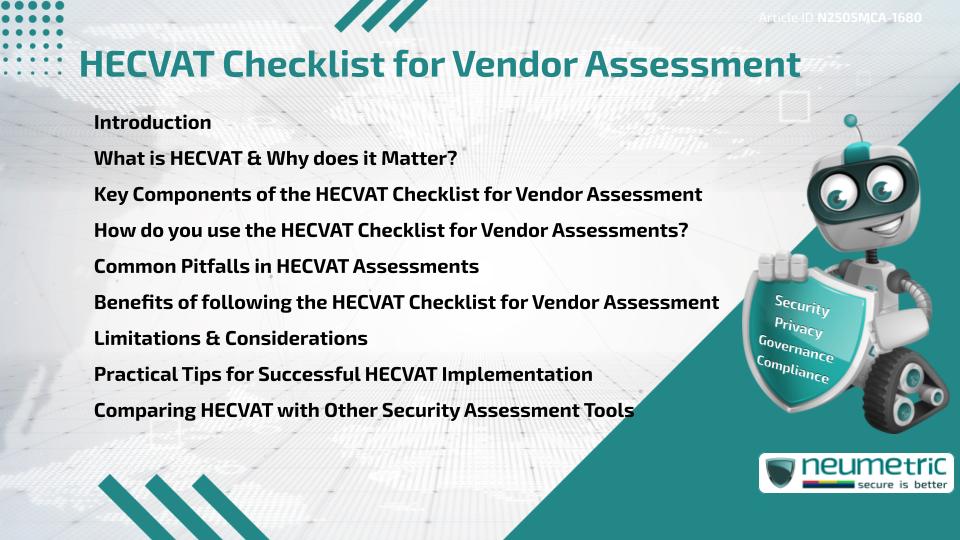Table of Contents
ToggleIntroduction
In the world of Higher Education, Cybersecurity is no longer just an IT concern—it is a strategic priority. As Institutions rely more on Cloud Service Providers & Third Party Tools, ensuring these Vendors meet required security standards becomes critical. This is where the HECVAT Checklist for Vendor Assessment plays a key role. Developed to streamline & standardise the evaluation of Vendors, this tool is widely adopted across Universities to reduce Risks & improve Transparency.
This article explores the purpose, use & limitations of the HECVAT Checklist for Vendor Assessment. We will explain its components, provide implementation tips & compare it to other assessment methods—all in a clear & easy-to-follow format.
What is HECVAT & Why does it Matter?
The Higher Education Community Vendor Assessment Toolkit [HECVAT] was created by the Higher Education Information Security Council [HEISC] with support from EDUCAUSE & Internet2. It provides a Framework to help Colleges & Universities assess the Risk posed by Third Party Vendors, especially those handling Sensitive Data like Student Records, Research & Financial Transactions.
HECVAT is important because it bridges the gap between Compliance & Operational needs. Without a standardised method like the HECVAT Checklist for Vendor Assessment, Institutions face inconsistent vetting processes, which can lead to Security Gaps.
You can learn more from this EDUCAUSE overview.
Key Components of the HECVAT Checklist for Vendor Assessment
The HECVAT Checklist for Vendor Assessment comes in different forms based on the level of Risk:
- HECVAT Full: Used for High-Risk Services involving Sensitive or Regulated Data.
- HECVAT Lite: A shorter version for Lower-Risk Services.
- HECVAT On-Premise: Designed for solutions hosted within an Institution’s own Infrastructure.
Each form of the checklist covers areas such as:
- Data Governance & Handling
- Security Controls & Policies
- Incident Response & Business Continuity
- Access Management & IdentityVerification
- Compliance with Standards like FERPA, HIPAA & GDPR
Full Version may include over two hundred (200) questions, making it suitable for deep Vendor evaluations.
How do you use the HECVAT Checklist for Vendor Assessments?
Using the HECVAT Checklist for Vendor Assessment starts with understanding the service being evaluated. Institutions should:
- Identify Risk Level: Determine if the service handles Protected or Regulated Data.
- Select the Right Form: Choose between Full, Lite or On-Premise based on the Risk.
- Engage the Vendor: Share the appropriate HECVAT Form & request detailed Responses.
- Review Responses: Assess the Vendor’s answers for adequacy, clarity & red flags.
- Document Outcomes: Record the results in internal Risk Management Systems.
It is also helpful to maintain a central repository of completed HECVAT Forms for Future Reference or Audits.
Common Pitfalls in HECVAT Assessments
Despite its usefulness, the HECVAT Checklist for Vendor Assessment is not without challenges. Some of the most common issues include:
- Incomplete Vendor Responses: Vendors may leave sections blank or provide vague answers.
- Overreliance on the Checklist: Assuming the checklist alone guarantees Vendor security can be risky.
- Poor Follow-Up: Failing to ask for clarifications or additional documentation weakens the assessment.
To avoid these issues, Institutions must treat the HECVAT as a Conversation Starter, not just a Checkbox Exercise.
Benefits of following the HECVAT Checklist for Vendor Assessment
There are several advantages to using the HECVAT Checklist for Vendor Assessment:
- Standardisation: Ensures every Vendor is evaluated using the same criteria.
- Efficiency: Reduces the time spent creating unique assessments for each Vendor.
- Transparency: Builds trust between Institutions & Service Providers.
- Risk Reduction: Helps identify Security Weaknesses before Contracts are signed.
Limitations & Considerations
While the HECVAT Checklist for Vendor Assessment is useful, it is not a silver bullet. Here are a few limitations:
- Self-Reported Information: The accuracy of responses depends on Vendor honesty.
- Not legally Binding: It is a Tool, not a Contract or Audit.
- No Real-Time Validation: The checklist does not verify real-time Compliance or System Health.
Institutions must therefore combine HECVAT with Technical validation methods like Penetration Testing or SOC Reports.
Practical Tips for Successful HECVAT Implementation
To get the most out of the HECVAT Checklist for Vendor Assessment:
- Train Stakeholders: Ensure Procurement, IT & Legal Teams understand how to interpret results.
- Create a Review Workflow: Define who is responsible for reviewing & approving Vendor submissions.
- Communicate Expectations Early: Let Vendors know up front that HECVAT Compliance is required.
- Combine with Other Tools: Use HECVAT alongside ISO 27001, SOC 2 or Penetration Testing findings for deeper insights.
Comparing HECVAT with Other Security Assessment Tools
The HECVAT Checklist for Vendor Assessment is uniquely tailored to the needs of Higher Education. However, other tools are available:
- Standardised Information Gathering [SIG]: Commonly used across Enterprise Environments.
- Consensus Assessment Initiative Questionnaire [CAIQ]: Provided by the Cloud Security Alliance to assess Cloud Service Security.
- Vendor Risk Rating Frameworks: Often proprietary but customised by organisations for sector-specific needs.
While these tools may offer more flexibility, HECVAT remains the most directly aligned with the unique Compliance needs of Academic Institutions.
Takeaways
- The HECVAT Checklist for Vendor Assessment provides a unified approach to Third Party Risk evaluation in Higher Education.
- It includes Standard Questions covering Security, Compliance & Operational practices.
- Successful use depends on proper implementation, Stakeholder Training & Follow-up.
- Institutions should combine HECVAT with Technical & Contractual measures for stronger Risk Management.
FAQ
What does the HECVAT Checklist for Vendor Assessment evaluate?
It evaluates a Vendor’s Security Controls, Data Protection Practices, Compliance Posture & readiness to handle sensitive information for Higher Education Clients.
Who should use the HECVAT Checklist for Vendor Assessment?
Procurement Teams, IT Departments & Data Protection Officers in Higher Education Institutions should use it to assess Third Party Vendors.
Is HECVAT only for Cloud Vendors?
No, while it was originally designed for Cloud Service Providers, it can be adapted for any Third Party Vendor handling Institutional Data.
Can Vendors reuse completed HECVAT Forms?
Yes, Vendors can share previously completed HECVAT responses, as long as the information remains current & accurate.
How long does it take to complete the HECVAT Checklist for Vendor Assessment?
Depending on the version & complexity of services, it may take anywhere from a few hours to several days.
Is the HECVAT Checklist legally binding?
No, it is a Risk Assessment Tool, not a Contract. However, it can inform Legal Agreements & Security Clauses.
What should you do if a Vendor refuses to complete the HECVAT Checklist?
Institutions can consider it a Red Flag & either request Alternative Documentation or choose not to proceed with the Vendor.
Does HECVAT replace the need for Audits?
No, it complements Audits & Technical Evaluations like SOC Reports or Vulnerability Scans.
Need help?
Neumetric provides organisations the necessary help to achieve their Cybersecurity, Compliance, Governance, Privacy, Certifications & Pentesting goals.
Organisations & Businesses, specifically those which provide SaaS & AI Solutions, usually need a Cybersecurity Partner for meeting & maintaining the ongoing Security & Privacy needs & requirements of their Clients & Customers.
SOC 2, ISO 27001, ISO 42001, NIST, HIPAA, HECVAT, EU GDPR are some of the Frameworks that are served by Fusion – a centralised, automated, AI-enabled SaaS Solution created & managed by Neumetric.
Reach out to us!


